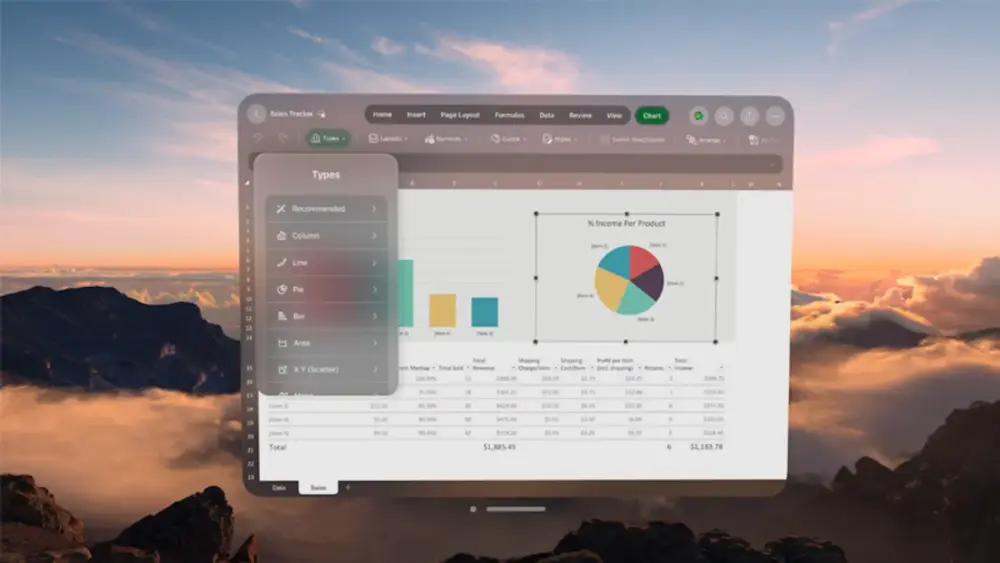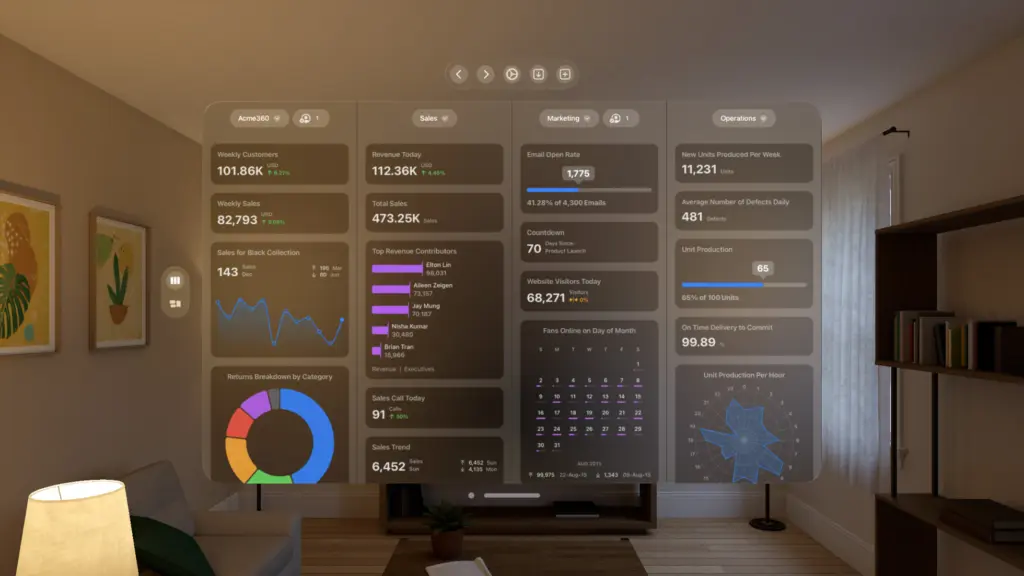
Apple Vision Pro – does your business need spatial computing headsets?
Apple’s Vision Pro mixed reality headset is here. Well, for those living in the US with $3,499 to spare. After years of rumours and leaks, Apple revealed the Vision Pro headset last summer, but it’s taken until now to arrive in stores.
The headset bridges virtual and augmented reality by allowing the user to choose to see the world around them using cameras. It also displays the wearer’s eyes on the front of the device, via a camera system called EyeSight. That means users can be completely immersed in a game à la rival virtual reality Meta Quest headsets, or can opt to see the world around them. It all helps to avoid the isolation of true VR headsets.
Apple dubs this combination of VR and AR “spatial computing”, though that really refers to how the Vision Pro could be used for multitasking when working. Strap it on and view your desktop in 3D around you, with apps to either side of a main display. You then interact using your hands (including via a virtual keyboard), voice or using eye tracking.
Practically, this means there are a lot of early adopters going viral wearing a goofy-looking headset on the New York subway, crossing the street, and, rather alarmingly, while driving Teslas. It all echoes the very first days of Google Glass — and look how that went. That said, Apple has one huge advantage over Google: an ecosystem of ready-made apps and an army of fans.
Apple Vision Pro reviews
So far the reviews are mixed but positive. Early testers are impressed by the hardware and the user interface but also find the EyeSight system weird and disconcerting.
Early reviewers reported that wearing the Vision Pro left marks on their faces, smeared their makeup and messed up their hair — perhaps no surprise given it’s a headset, but it does raise challenges about integrating the virtual world with the physical.
On the plus side, there’s already plenty to do. Apple has ensured a million iPhone and iPad apps are ready to be used on the Vision Pro, with 600 apps made just for the headset. These apps to watch films and play games, plus tools to view virtual 3D objects in the real world.

The folks at teardown site iFixit have already disassembled and analysed the Vision Pro, describing it as “insanely ambitious” by including the power of a Mac “into a computer that you can wear on your face”. (iFixit was also delighted by some of the connections Apple chose, including magnets to fix the face cushions.)
There are a few other points to know. The photos of the Vision Pro — whether promotional images released by Apple itself or snaps of users showing off their device — all focus on the headset. But that doesn’t include the battery, which is worn in the pocket. That makes sense, as shifts weight away from your head and, as iFixit notes, makes for easier replacement. Just be aware that the headset isn’t the total package.
Should businesses jump on this bandwagon?
It’s early days for the Vision Pro and for Apple’s “spatial computing” concept. The idea that home workers will strap on $3,500 headsets for the ultimate virtual workplace remains far-fetched. While the video above is slick, we’re not even sure spatial computing is better than staring at a webcam.
Dr Rolf Illenberger, Founder and CEO of VRdirect, notes that future iterations of the Vision Pro are likely to seriously improve upon this first-generation model, so there’s good reason to be patient. “There are substantial rumours that Apple already has next-gen devices already in the works, so, I’d advise against making an investment in buying a $3,500 device at this moment,” he says.
There are plenty of excellent use cases for VR and AR in business, though. After its initial stumble, Google Glass found a home in enterprise, used to aid repairs, scan warehouse items, and even in surgery, before being discontinued in 2023.
Whether your company can make use of the Vision Pro or not depends on two key factors. One, are suitable apps available, which we cover below. Two, whether the use cases have enough potential. The initial rush will likely be more about marketing than real purpose, with companies seeking to appear high-tech by offering Vision Pro experiences or grabbing for headlines by being the “first” spatial computing so-and-so.
That said, companies that can find a real purpose for this device, and pair that with a well-developed app, could be onto something. “Where businesses shouldn’t wait is in developing use-cases for VR technology with the understanding that there is a growing base of VR consumers ready to interact with it, both B2B and potentially as an improvement to the consumer experience,” adds Illenberger.
One thing is for sure: Apple is convinced. The Vision Pro was many years in the making, with R&D costing (we suspect) billions. While the spatial computing revolution has been promised many times before, this is its best chance at success.
Related reading: Apple is going to win the AR war – or no-one is
Business apps for spatial computing
So, what business-focused apps can you use on your spatial computing device from day one? Alongside all the existing apps that work on the Vision Pro, a handful have been built specifically for visionOS, the Vision Pro’s operating system.
Top of the list: Microsoft’s Office apps. Word, Excel, PowerPoint and Teams have been “optimised for the revolutionary capabilities of spatial computing,” according to Microsoft. “You can read through a document in Word, practice a presentation in PowerPoint, visualise your data in Excel, and collaborate with colleagues, all while staying immersed in your surroundings.”

Box has also created a visionOS app, complete with support for 3D objects, while “the MindNode app helps users brainstorm with thought bubbles that float around a user’s space” according to Apple.
Apple also mentioned OmniFocus and OmniPlan with the promise that you could “use beautiful data and project management visualization in large windows to view a complete project plan”. Meanwhile, it says, “Fantastical and Numerics make full use of the infinite canvas and sharp text rendering of Apple Vision Pro to make daily tasks effortless”.

Apple Vision Pro price and availability
If you just can’t wait, the Vision Pro is available now, but only in the US. You must pre-order on Apple’s website or in-store, as the kit requires personalisation. Measurements include the appropriately sized headband and “light seal” from 28 different options. People with prescriptions also need optical inserts, as glasses can’t be worn with the Vision Pro. The headset starts from $3,499 with additional charges for the optical inserts and storage. And Apple is charging an extra $400 to bump the Vision Pro from 256GB of built-in storage to a full terabyte.
The required personalisation suggests sharing a Vision Pro won’t be simple, though Apple assures on its website that it is possible. However, it says, other users “may need a different headband or Light Seal size for the best experience.”
It’s worth having a go with it first, advises Illenberger, who notes that US Apple Stores offer 30-minute demos. “Anyone who is remotely curious should go through that process,” he says.
As for non-US countries? No prices are yet available, nor local launch dates. All Apple has said is that it plans to offer the Vision Pro to more countries later in 2024.
Related reading: Why I’m still betting on Apple in the era of AI
NEXT UP

James McQuiggan, Security Awareness Advocate at KnowBe4: “Ironically, attack methods have remained unchanged over the past twenty years”
In this interview, we hear from James McQuiggan, Security Awareness Advocate at KnowBe4 and a part-time Faculty Professor at Valencia College in Florida.

What is ocean-bound plastic and should you care?
Lee Grant digs behind the truth about ocean-bound plastics to explain why reducing them is a worthy cause – but that we need to treat marketing claims with due scepticism

Slow buyers cause tech firms to rethink sales approaches as tough Q1 hits home
New research suggests tech sales were slow in Q1, with buyers of technology and professional services taking their time before committing to any solutions.
